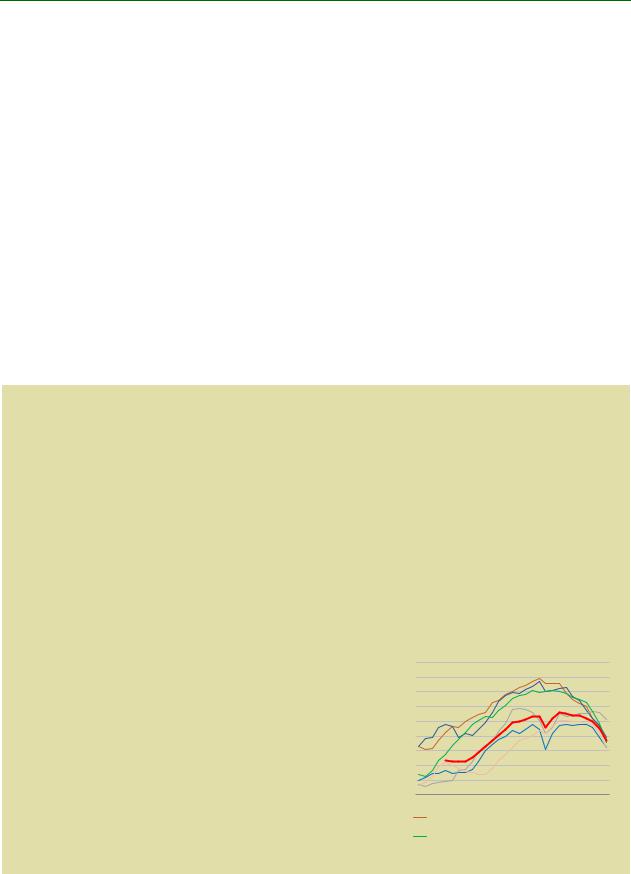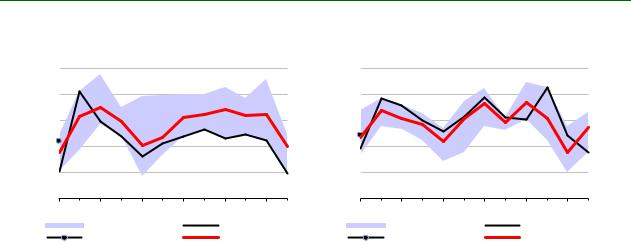
- •HIGHLIGHTS
- •TABLE OF CONTENTS
- •Supply cushion insures against losses
- •DEMAND
- •Summary
- •Fundamentals
- •OECD
- •OECD Americas
- •OECD Europe
- •Europe disaffection for diesel accelerated in 2018
- •OECD Asia Oceania
- •Non-OECD
- •China
- •India
- •Other Non-OECD
- •SUPPLY
- •Summary
- •OPEC crude oil supply
- •Non-OPEC overview
- •REFINING
- •Summary
- •Margins
- •OECD refinery throughput
- •Non-OECD refinery throughput
- •STOCKS
- •Summary
- •Recent OECD industry stock changes
- •OECD Americas
- •OECD Europe
- •OECD Asia Oceania
- •Other stock developments
- •PRICES
- •Market overview
- •Futures markets
- •Spot crude oil prices
- •Spot product prices
- •Freight
- •TABLES
- •Table 1: World Oil Supply And Demand

vk.com/id446425943
DEMAND INTERNATIONAL ENERGY AGENCY - OIL MARKET REPORT
Jet fuel demand dropped by 30 kb/d y-o-y in 4Q18, after strong growth of 65 kb/d in 3Q18. Demand declined by 5 kb/d on average in November-December. Domestic air traffic (revenue passenger kilometres or RPK) rose by 4.0% in December and accelerated to 5.8% in January.
Canada’s oil consumption declined sharply in December, on low LPG/ethane and naphtha demand. For 4Q18 as a whole, demand contracted by 35 kb/d y-o-y. Gasoline demand rose by 30 kb/d in 4Q18 and gasoil/diesel demand by 35 kb/d. Mexico’s oil demand declined by 50 kb/d y-o-y in 4Q18, on poor gasoline numbers. Theft from pipelines and government efforts to combat it may have resulted in shortages.
Total North American oil demand, after rising strongly by 475 kb/d in 2018, will see a small slowdown in 2019, with growth easing to 400 kb/d. A large part of the growth will come from LPG/ethane (170 kb/d) while gasoline demand should see a strong rebound after a weak 2018.
OECD Europe
European oil demand fell back significantly at the end of 2018, on strong declines in naphtha, gasoil and fuel oil deliveries. This partly reflects a sharp deceleration in economic activity and disaffection for diesel cars.
Europe disaffection for diesel accelerated in 2018
Diesel engines cause air pollution problems in large cities because of the emission of particulate matter (PM) and nitrogen oxides (NOx). PM can penetrate deep into human lungs, while NOx contributes to breathing difficulties by increasing ground level ozone. In Europe, the problem is not the lack of stringent regulations limiting air pollution. The Euro 6 standard is one of the toughest in the world, yet enforcement in real world situations has been a big issue. German courts have imposed bans on diesel cars in certain specific areas of several cities, including Hamburg, Dusseldorf, Munich and Stuttgart. Several other European cities are considering similar measures, including Madrid, Paris, London and Athens. Rome plans to ban private diesel vehicles from 2024.
In recent years, there has been a massive change in consumer demand affecting the automotive industry. In spite of assurances by the industry that new diesel cars have very low NOx and PM emission, sales have fallen sharply to be replaced mainly by gasoline cars and a modest penetration of electric vehicles. The European Automobile Manufacturers Association reported that in 2018, the share of diesel in total car sales in the European Union fell to 35.9% from 44% in 2017 while the
share of gasoline cars rose to 56.7% from 50.3%. Only 2% of new |
% |
Share of diesel in Europe car sales |
cars sold in 2018 were electric. |
90 |
|
|
|
|
Gasoline car sales rose 12.8% in 2018 in Europe, but the sales of |
80 |
|
70 |
|
|
diesel cars dropped by 18.3%. In the main markets, diesel car sales |
60 |
|
dropped by 16.9% in Germany, 12.1% in Italy, 15.4% in France |
50 |
|
29.6% in the UK and 20.7% in Spain. In the meantime, gasoline car |
40 |
|
|
|
sales rose by 7.9% in Germany, 18.3% in France 8.7% in the UK, |
30 |
7.9% in Italy and 29.7% in Spain. |
20 |
|
|
|
10 |
Last year, 14 million gasoline and diesel cars were sold in Europe. Diesel car sales declined by 1.21 million in 2018 compared with 2017 while gasoline cars sales rose by 0.97 million. These changes will have a significant impact on transport fuel sales in the medium term.
0 




























 1990 1992 1994 1996 1998 2000 2002 2004 2006 2008 2010 2012 2014 2016 2018
1990 1992 1994 1996 1998 2000 2002 2004 2006 2008 2010 2012 2014 2016 2018
BELGIUM |
|
FRANCE |
|
|
GERMANY |
|
ITALY |
|
|
|
|||||
SPAIN |
|
UK |
|
|
EU-15 |
|
|
|
|
|
|
|
8 |
15 MARCH 2019 |

vk.com/id446425943
INTERNATIONAL ENERGY AGENCY - OIL MARKET REPORT DEMAND
mb/d Germany: Total Products Demand
2.6 |
|
|
|
2.5 |
|
|
|
2.4 |
|
|
|
2.3 |
|
|
|
2.2 |
|
|
|
2.1 |
|
|
|
JAN |
APR |
JUL |
OCT |
|
Range 14-18 |
|
2018 |
|
2019 |
|
5-year avg |
mb/d France: Total Products Demand
1.9 |
|
|
|
1.8 |
|
|
|
1.7 |
|
|
|
1.6 |
|
|
|
1.5 |
|
|
|
1.4 |
|
|
|
JAN |
APR |
JUL |
OCT |
|
Range 14-18 |
|
2018 |
|
2019 |
|
5-year avg |
German oil demand declined by 135 kb/d y-o-y in 4Q18 after a drop of 150 kb/d in 3Q18, on very low naphtha and gasoil demand. In 4Q18, naphtha demand dropped by 90 kb/d and gasoil demand by 20 kb/d.
Gasoil deliveries dropped by 85 kb/d y-o-y in November and 20 kb/d in December. In January, according to provisional data, gasoil demand jumped by 120 kb/d y-o-y. These variations partly reflect logistical constraints. Very low water levels on the Rhine during extended periods of time constrained supplies of gasoil to Germany and Switzerland and freight rates for barges on the Rhine reached an historical high on 30 November. Water levels rose in December and the German market is now better supplied.
Diesel demand has been impacted by slowing economic activity and concerns about pollution and falling resale values of diesel vehicles. GDP declined by 0.2% in 3Q18 and remained unchanged in 4Q18. Industrial production dropped by 3.3% y-o-y in January.
Oil demand in France rose by 20 kb/d in 4Q18, but demand fell by 115 kb/d y-o-y in December on low gasoil/diesel deliveries. Provisional data point to total products demand growth of 55 kb/d in January, supported by a rebound in gasoil/diesel deliveries. In Italy, oil demand rose by 5kb/d in 4Q18 after growth of 20 kb/d in 3Q18. Gasoil demand remains strong.
Overall, European oil demand fell by 270 kb/d in 4Q18 and is projected to drop by a further 130 kb/d in 1Q19. For 2018 as a whole, demand fell by 25 kb/d, but there will be a rebound in 2019 to 55 kb/d.
OECD Asia Oceania
OECD Asia Oceania demand declined by 365 kb/d y-o-y in 4Q18. The slowdown was reflected in the majority of products.
Japanese demand fell by 165 kb/d y-o-y in 4Q18, on lower deliveries of almost all products. Higher than normal temperatures reduced kerosene demand. In December, air passenger traffic rose by 4.7% y-o-y but kerosene deliveries were lower. In 1Q19, there will be another, smaller, drop of 140 kb/d. In January, domestic RPK grew by 3%. For 2018 as a whole, Japan’s oil demand fell by 115 kb/d and in 2019, there is likely to be a further fall of 105 kb/d.
15 MARCH 2019 |
9 |
